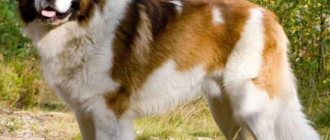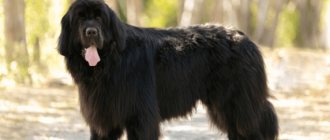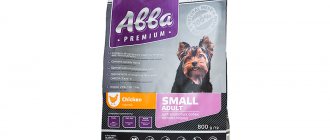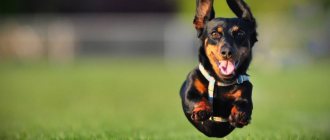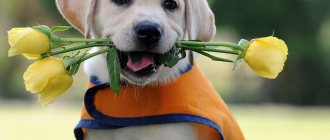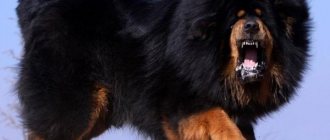- August 28, 2018
- Dogs and hunting with them
- Roman Karpets
Duck and goose hunting is an exciting activity for real men, starting in early spring and ending in late autumn. Very often, specially trained dogs are brought in to help, capable of lifting game onto the wing and serving it to its owner, pulling it out of the water so as not to damage the integrity of the hunted bird. Today's post will provide brief descriptions of the best dog breeds that can cope with this task.
Labrador
These animals were bred in the 20th century on the Canadian island of Newfoundland. According to unconfirmed reports, setters, curly-coated retrievers and small local dogs were used to obtain them.
The Labrador is a compact, strong dog, growing to 54-57 cm at the withers and weighing 26-32 kg. The voluminous, broad-browed head with a moderately long muzzle and smooth stop has dark oval eyes and triangular hanging ears. The square body with a deep chest and short loin is covered with a hard, waterproof coat of black, chocolate or fawn.
Labradors are ideal gun dogs for duck hunting. They are not afraid of water and are capable of apportation. These hardy dogs, not afraid of the cold, have sufficient physical strength to easily get through reed or reed thickets and retrieve shot game from there. They will be excellent companions for those who do not like to rush and want to be alone with nature longer.
Labrador Retriever
Retrievers were bred as hunting dogs (English retrieve - get, find). All retrievers have excellent hunting instincts, but the Labrador is an exceptional hunter. Energetic, with a warm coat designed for long outdoor hunts, and willing to go to any lengths to get your prey, Labrador Retrievers are the best dogs for hunting ducks and other birds. Just make sure your hungry lab doesn't eat your bird itself.
Pointer
The birthplace of these animals, the first mention of which dates back to 1650, is considered to be Great Britain. According to experts, greyhounds, bloodhounds, foxhounds and setters took part in their formation. They came to Russia in 1914 and since then have not lost popularity among professional hunters.
The Pointer is not too large, a harmoniously built dog, growing up to 62 cm at the withers and weighing 20-30 kg. On a large head with a slightly upturned muzzle and an elongated upper jaw, there are round, expressive eyes and soft, drooping ears, the shape of which resembles a triangle. The strong body with a slightly sloping croup is covered with a short, close-lying coat of fawn, coffee, black, red or piebald.
Pointers are versatile duck hunting dogs. They are very hardworking, obedient and passionate. Representatives of this breed have a stable psyche, are not afraid of shots and are able to bring killed game. However, they do not like water too much, so they will have to be trained first.
Groups of hunting dogs
Which dogs are better at hunting? In fact, the types of hunting breeds are diverse and include not only greyhounds and hounds, as some believe. All dogs that are suitable for catching prey are divided into 6 main groups. A person’s success in pursuing game largely depends on the right choice.
Greyhounds
These are quite large dogs, very strong, and can easily bear loads. They have sharp eyesight and high running speed. Pets are suitable for catching foxes, small ungulates, and hares. The tactics for catching an animal are as follows: upon seeing it, the dog develops high speed, catches up, and strangles the animal. Dogs can be used in open areas, in forests, forest-steppes, but their sense of smell is not very sensitive.
Hounds
These beautiful short-haired dogs, bred specifically for hunting, are designed to catch hares, foxes, and wild boars. They have an excellent sense of smell, persistence in pursuing game, and great vitality. The description of the breeds is as follows: large animals with hanging long ears, brown coat color with large white and black spots.
Hunting with hounds goes like this: the pet finds the animal by smell, barks loudly and runs after it, driving it towards the owner. A person shoots from cover when the position is comfortable. These dogs do not kill game, they are very friendly, adore children, and do not harm other pets.
Burrows
These dogs are small, active, and are used to catch animals in burrows. They climb straight into the hole, chase the fox and badger out of the second exit towards the hunter. A dog can also pull an animal out of a hole with its teeth. In addition to burrowing animals, such pets are capable of hunting birds and hares. They have one minus - they do not get along with other animals in the apartment.
Likes
Laikas are considered universal and the most popular dogs in the “hunting top”. They can be chosen to catch any bird, fur-bearing animals, ungulates and even bears. They have an excellent sense of smell, endurance, and speed are also excellent. Likes, despite the name, are far from noisy. They chase the game, silently, having caught up, they do not allow them to come to their senses and run away with loud barking and driving, biting. Laikas kill ducks themselves and bring them to the owner. As a guard dog, huskies lose: they are too friendly.
Cops
These purebred animals serve as gun animals - at the moment of the shot they are next to the person, “under the gun.” Cops are hardy, patient, and have excellent instincts. Dogs are best suited for catching birds. Smelling it, the dog sneaks up, comes close and takes a stance, which is the “calling card” of the breed. The man gives the command to throw, the bird takes off, and a shot is heard. Afterwards, the cops help find the killed game in the swamp, on the water meadow.
Spaniels and retrievers
Some of these dogs in Russia work as service dogs. They are of medium size, have a good disposition, and an easy-going character. Dogs love water, which is why they are often used to hunt waterfowl. Animals are even able to dive after a duck that has gone under water. A distinctive feature is the absence of damage to game by the dog due to its careful attitude. The hunting instincts of such dogs are very high, but they get tired quickly and cannot run long distances.
English Setter
The history of this breed began in the 17th-18th centuries, when people did not have the opportunity to use hunting weapons and they had to catch wild birds with nets. To search for ducks or partridges hidden in the reeds, specially trained dogs resembling spaniels were used. Later, these dogs began to be crossed with Spanish pointers. And to consolidate working qualities, the blood of Irish water spaniels was mixed into the resulting mestizos.
The English Setter is a fairly large dog, growing up to 61-68 cm and weighing 20-36 kg. The well-proportioned, broad-browed head has expressive dark eyes and floppy, soft ears. And the entire graceful body is covered with luxurious white fur with black or red spots, which reliably protects against adverse external factors.
The English Setter is one of the best hunting dog breeds. The nest of someone who owns such a dog, which has undergone special training, will never be empty. These are very hardy and tireless animals, capable of working in difficult and overgrown areas.
Irish Setter
These dogs were bred in the 18th century specifically for hunting swamp, steppe and upland game. Their homeland is Ireland, and among their closest ancestors are spaniels and pointers. They received official recognition in 1876 and have remained at the peak of popularity ever since.
The Irish Setter is a fairly large dog, its height is 55-67 cm and its weight is 25-34 kg. On a dry, elongated head with a pronounced occipital protuberance and a tapering muzzle, there are oval, slightly slanted eyes and low-set, hanging ears. The square body with a narrow, deep chest and a flat back is covered with thick, fiery red hair of varying lengths.
Irish Setters are one of the best duck dogs. They help find hidden game and present it to their owner. These hardy, hardworking, obedient and smart dogs require persistent but gentle training and do not tolerate rough treatment.
Russian hunting spaniel
This breed of dog appeared in the middle of the 19th century. She was bred from Springer Spaniels and English Cockers. Despite its incredible popularity and excellent performance, it has still not received official recognition from the FCI.
The Russian Hunting Spaniel is a squat dog, growing to 36-44 cm at the withers and weighing no more than 16 kg. The moderately long, dry head with a smooth stop and strong jaws has expressive dark eyes and soft, long ears that fit tightly to the cheekbones. The entire body is covered with wavy hair, forming dewlap and fringes. As for color, it can be one, two or three colors.
ROS is one of the best dogs for hunting ducks and other waterfowl. He does an excellent job of finding and bringing in shot prey. This hardy dog has excellent sense of smell and is able to easily move through swampy or reed-covered areas.
Duck hunting dog
Duck hunting undoubtedly requires special qualities from a dog - both natural and instilled through training. Breeding such a breed is the task of local hunters, and identifying rational requirements for such dogs is the task of our field tests.
The foreign breeds of water spaniels and retrievers are unlikely to be quickly and widely accepted in our country, if only because these dogs are expensive, it is difficult to get them from abroad, it is soon impossible to distribute them, and, finally, their working qualities are completely unknown in our harsh conditions. Here it is necessary to use the material available at hand and, moreover, in sufficient quantity. What should we demand from a duckling dog?
Required qualities
The dog must have a powerful build, well-developed muscles and as tall as possible (at least 15 inches for males and 14 for females). These qualities are necessary to move freely through hummocks and grassy swamps, as well as to swim among aquatic plants. Well dressed with warm and long hair, the dog easily tolerates work in cold water, which is why this quality is far from indifferent. Color is also of no small importance, since a white dog will be difficult to hide on a seat when hunting during flights. Black is also noticeable, especially in daylight, but is still preferable to white. A red dog is already less conspicuous, especially in the fall. The best color is undoubtedly gray. The dog must have a highly developed hunting passion, otherwise it will soon give up tedious climbing over hummocks, in thick grass or cold water in the fall.
Serving game
It is necessary that the dog has a natural tendency to retrieve (which most English bloodlines do not have), otherwise it will be difficult to train it, and you can never be sure that the dog will not become capricious at the right moment. After all, feeding from the water and, moreover, reliably, at least several times in a row, despite the weather, is the main requirement for this type of dog. The search should not be too fast: the frantic gait of the British during duck hunting is unnecessary and harmful. Indeed, in most cases you have to hunt along the shores of lakes, where the dog’s field of activity is reduced to a narrow strip of water overgrown with vegetation. Under these conditions, the dog, during a quick search, will involuntarily move too far away from the hunter, irritate him, scare off the guard bird, demand incessant calls, etc. Flair, of course, the stronger the better. The eyeliner is not tight, the stand is by no means dead, since otherwise there is no way to raise a lazy young mallard, especially in the heat. The character of the dog is desirable, perhaps soft (as for any bird hunting dog), but still it must be a sensitive watchman, especially when spending the night in the field. Of course, you don't need a bulldog for this.
The basis of training such a dog is to teach it to retrieve without fail, both from dry land and especially from water, no matter what the weather and water temperature and at least several times in a row. For this purpose, it is advisable to keep the dog outdoors all year round, since an indoor dog will never work well in the late fall and can get dangerously cold. The dog must firmly know: “back and forth”, be appellant, that is, obey the whistle well, even the lightest one, and walk at the foot. Of course, a firm knowledge of “down” or “lie down” at a distance is necessary, since you often have to hide at the sight of flying birds, and a prowling dog, if it doesn’t scare away the ducks, will at least make them wary.
When hunting by stealth, it is often more profitable to leave the dog in place and walk or crawl alone. Here it is necessary that the dog, left lying in place, remains there until it is called. Very often, however, it happens that a smart dog itself understands the need to approach unnoticed and makes its way behind a crawling hunter, also crawling - these dogs are very much valued by duck hunters. Rushing after a bird that has flown out or after a shot is a vice that must be weaned off by all, even harsh, measures. The dog must find, catch and bring to the hunter a wounded duck (not at all strangled), but this should never be combined with catching flightless ducklings or unwary summer young: such “dog hunting” is unworthy of either the hunter or the dog. The dog perfectly distinguishes between a healthy bird and a wounded one. The habit of crushing game is a vice that often cannot be corrected, but it is rare in dogs with an admixture of poodle blood. The dog must be able to search, following the instructions of the hunter's hand. If you need to control a dog by shouting, then you cannot use it to hunt watchful autumn birds. In a boat, the dog must behave quietly. It is imperative to become accustomed to this, otherwise accidents can easily occur.
In our opinion, the best way to obtain a duck hunting dog is by crossing an Irish or Gordon Setter or, finally, an English Setter with a Poodle. The latter, as a less passionate dog, by nature extremely intelligent and polite, well dressed, strong, with almost congenital diarrhea, easy to train and, finally, possessing hunting qualities in itself, will be just suitable for mixing with a setter who will give it the best instinct, search and passion. Of course, it is better to mix blood specimens, but in the end this is not even so necessary; it is much more important to take into account the field qualities of the producers, especially on the part of the setters.
Vedi, 1925
English cocker spaniel
These animals, descended from fold-eared dogs that specialized in bird hunting, have a very long history. Great Britain is considered their homeland, and they came to Russia only in the 20th century.
The English Cocker Spaniel is a small, harmoniously built dog with a beautiful head, expressive eyes and long hanging ears. The dog's compact body is covered with straight, silky hair of sable, black, chestnut, red or spotted color.
Miniature size and pretty appearance do not prevent the English Cocker from being an excellent hunting dog. Ducks and geese are not a complete list of objects that you can go to with your spaniel. This dog is endowed with good eyesight and an excellent sense of smell, which helps him find game.
Hunting dogs spaniels and retrievers
Cockers and spaniels are the predecessors of cops. They are very passionate, smart, and will meticulously search the entire area so as not to miss the game. These dogs have no equal when hunting on water.
English cocker spaniel
Fold-eared dogs are brown in color and medium in size. They will find any trace, having an excellent instinct, and persistently search for game. They are highly trainable and follow commands without question.
Russian hunting spaniel
The breed was bred for catching swamp, water, and field birds. The dog will find her even in the thickets, more often, and without unnecessary sounds. The spaniel will then pick up the feathered animal and the hunter will fire a shot. Training goes quickly, and the dog even understands gesture commands.
American Cocker Spaniel
Very strong, active dogs. They get along with animals at home and get along with children. Widely used in the extraction of furs and any poultry.
Clumber Spaniel
The dog is the largest of this group, it is white with brown streaks in the neck and muzzle, and looks squat and slow. Despite some laziness, the pet is patient and perfectly hunts partridges and pheasants.
Japanese Chin
A Japanese dog used to be worth its weight in gold, and even now it is quite expensive due to its beauty and aristocracy. This baby is more decorative, but can hunt rabbits and hares.
Cavalier King Charles Spaniel
Another “noblewoman”, a beautiful, intelligent beast. He is good at poultry and small animals, and gets along well with people.
Epagnol Breton
The most hardworking dogs, they are not frightened by bad weather or cold. They love to catch partridge, duck, pheasant, and are excellent at training.
Continental Toy Spaniel
Dogs are decorative and can have two types of ears – erect and hanging. They are only capable of hunting mice.
Welsh Springer Spaniel
The dog is small, but quite hardy. Does not tolerate rough treatment, shouting, beating. Designed for bird hunting.
Tibetan Spaniel
The age of the rock is large - about 2 thousand years. Previously, animals served as guards of monasteries, after which they began to be used for catching birds. They are persistent in searching for prey, leading it at any distance.
Irish Water Spaniel
The Water Spaniel is a large dog and includes show and working types. The breed was created on the basis of Afghans. Participates in hunting birds and fur-bearing animals.
Labrador Retriever
A very smart dog, he will wait for the hunter until he takes a comfortable position, and only then he will pick up the game. The dead bird is brought back without the slightest damage. Some dogs are afraid of gunshots, which can be a problem when hunting.
Drathaar
The homeland of these versatile hunters is Germany, and among their ancestors are griffins, stichelhaars, pointers and shorthaired pointers.
Drathaar is a strong, harmoniously built dog, whose weight ranges from 27-32 kg, and whose height is 56-68 cm. On a beautiful, proportional head with a flat forehead, pronounced cheekbones and prominent eyebrows, there are graceful ears raised on cartilage and small round eyes. The square or slightly elongated body is covered with thick, coarse hair of black, brown, chestnut or gray color.
Drathaars are a versatile breed of dog for hunting. You can safely go hunting for ducks, pheasants, hares, raccoons and even wild boars with this reliable dog. He works with equal zeal on animals and game birds. In the first case, he searches for prey by smell, in the second, he relies on acute vision.
Duck hunting dog breed
A duck hunting dog breed must have a number of certain qualities so that it can be successfully hunted throughout the entire hunting season.
Let's consider several of the most important qualities of a hunting dog that is planned to be used in duck hunting.
- The dog simply must be able to swim well and not be afraid of water, since the hunt will be for waterfowl.
2. The size of the dog should be small, since this will make it easier for him to overcome dense thickets of reeds.
3. In addition, the dog will need good endurance, which it will need to persist in finding and chasing the duck.
4. The ability to serve game from the water is a mandatory quality. Due to the specific smell, some dog breeds may not accept duck at all.
5. The presence of obedience in a dog helps not to scare away the duck at the wrong moment, so this quality should also be at a high level.
Now let's look at some of the most popular breeds of duck hunting dogs that are recommended for use in duck hunting.
Among the entire list of breeds, the Laika deserves special attention. This dog is commonly called a universal hunting dog. Thanks to its dense undercoat, the husky is perfect for serving ducks from the water.
According to the rating of adaptability to duck hunting, pointing dogs take first place. This opinion is due to the fact that they have a very good sense of smell, which allows them to smell a duck at a considerable distance and maintain a stance until the hunter’s command.
Among the pointing dogs, one can distinguish the pointer and shorthaired pointer. For example, the Pointer is characterized by excellent intelligence and a unique passion for competition. When hunting, he behaves very bravely, but at home he is friendly and devoted to his owner.
The shorthaired pointer is used in duck hunting by many hunters because it has amazing energy and courage.
Among small dogs, the spaniel is the undisputed leader for duck hunting. It is very hardy and moves well in dense thickets.
The spaniel has well-developed upper and lower senses. The dog does not stand, but when it detects game it stops for a moment and then lifts the bird onto its wing.
Many hunters praise the Labrador and recommend using it in hunting as the main breed of dog for duck hunting.
According to its physical characteristics, this dog is not a small breed, but it can swim very quickly, which is a necessary quality for this hunt.
In terms of training, this breed is very capable because it learns easily. Among people he behaves friendly and does not show aggression.
Thus, the breed of duck hunting dogs is represented by several representatives, each of which is worthily used in hunting.
Kurzhaar
This breed was developed in Germany in the mid-19th century. Its main purpose is hunting. And among the closest ancestors are Spanish and English pointers.
Those who are trying to find out which duck hunting dog is suitable for the role of a companion and can be kept in a city apartment should pay attention to the Shorthaired Pointer. This large dog, weighing 26-35 kg with a height of 55-65 cm, gives the impression of a strong and noble animal. His proportionate body is covered with short hair that does not require special care.
The shorthaired pointer is an unsurpassed hunter not only of game birds, but also of large animals. He needs special training and regular long walks. He is very active, cheerful and peaceful. This dog gets along well with children and loves to swim.
Breeds of hunting dogs for hunting game
A good hunting dog is an integral part of hunting swamp or meadow game. This hunt without dogs is either impossible, but often simply uninteresting.
After all, when hunting, it is important not only to get game, but also to get maximum pleasure, and what could be more wonderful when your prepared pet finds game in swamps and meadows, stands in a stance, signaling you. Gives you the opportunity to prepare for a shot and only after your command, the dog raises the game on its wing and... The game is caught! Afterwards, the hunting dog will pick up the killed game in the most impenetrable thickets and serve it to you. So you don’t have to look for game yourself in swampy swamps, which sometimes become fruitless.
In Fig. the most popular breeds of cops for hunting
Typically, many game birds, like swamp game, are hunted with the following breeds of hunting dogs - Pointer, English, Irish, Scottish Setter, Shorthaired Continental, Wirehaired and Longhaired Pointing Dogs and Spaniels.
There are also other breeds of hunting dogs, such as the Hungarian pointer, pointer poodle, Munsterlander, griffin, but these dog breeds are used much less frequently than the above.
Now let's look at the qualities of each breed of hunting dog so that you can choose the right dog for your hunt:
Pointer
The Pointer is a large, muscular dog breed with short hair. The Pointer's color can be solid: black or brown, as well as spotted white, with black, red, yellow or brown spots.
This breed of dog is valued for its flair, instinctive qualities of a hunter, efficiency, and firm stance on birds. These qualities appear in the Pointer already at 6 months of age. Very trainable. The disadvantages are that in cold weather, due to its short coat, it cannot work for a long time and the wool is easily susceptible to cuts in bushes.
English Setter
The English Setter is a beautiful purebred dog with magnificent long hair. The color scheme of the coat is different: black, coffee, red, yellow-piebald and tricolor, very rarely pure white.
The qualities of a hunter in the English Setter are no worse than the Pointer, he has an excellent sense of smell, when working on game he immediately covers a larger range of space, and when detecting game his stance is mainly recumbent. The only downside is training; you need to spend time training your pet.
Irish Setter
The Irish Setter is temperamental, hardy, fast, with a wide range of search, with an excellent sense of smell, with long wavy hair, solid red color, with white spots.
When hunting, he clearly determines the location of the game, stands in a high stance and, at the command of the owner, lifts the game. When training, you need patience, devote training every day, but do not make it long.
Scottish Setter - Gordon
The Scottish Setter Gordon is very hardy, persistent, and works in any terrain when hunting. The color is black, with red tints at the ends of the coat. Inferior to previous dogs in beauty, speed and range of search, but in comparison with the previous ones, it is more resilient, calm and easy to train.
Some scientists classify this dog breed as a dog with above average intelligence.
Kurzhaar - shorthaired pointer
The short-haired pointing pointer is universal when hunting all types of game birds. Very hardy, strong, pliable, which is reflected in the dog’s ease of training and training. Color ranges from black to coffee, with spots of various shapes and locations throughout the body.
It works easily both by scent and by upper scent; some hunters use it by blood trail.
Drathaar - wirehaired pointer
The wire-haired pointer drathaar is no different in quality from the short-haired pointer, but due to its coarse hair, it is better suited for working in thorny bushes and impassable terrain.
This breed of dog is universal; many hunters use it for both poultry and large animals (bear, wild boar). When a bird is detected, the dog takes a stance and, at the hunter’s command, picks up the game. When hunting a large animal, she barks at it, giving the hunter the opportunity to approach the animal to the distance required for a shot.
Langhaar - longhaired pointer
The long-haired Langhaar is a hardy, energetic, long-haired dog with a color ranging from brown to coffee. She is excellent at learning any techniques in the field, she also works on water, and her coat will protect her even in inclement weather.
Other hunting dog breeds described above are inferior in scent and are reluctant to work at the beginning of the hunt. It will also be necessary to pay attention when training to independently raise waterfowl.
Spaniel
Spaniel - among the described dog breeds, it is much smaller and does not hold a stance when a bird is detected, but despite what has been said, it is an excellent hunter. The spaniel is easy to train, intelligent, has an excellent sense of smell, has the correct range of searching for game, is very devoted to its owner, and when it detects game, it can walk around it and direct it towards the hunter.
Works great in the field and on the water. In this connection, it calmly detects wounded animals or shot game, both in water and on land, and serves it to the hunter.
We briefly looked at some breeds of hunting dogs and their qualities; I would like to add that it is best to take the dog as a puppy and train it yourself the way you would like to see it working in the field. From puppyhood, your dog will understand you and follow all your commands.
Flat-Coated Retriever
These animals were bred in Canada in the 17th century. Their appearance clearly shows a family connection with water spaniels, Labradors, collies, small Newfoundlands, Scottish and Irish setters. The final formation of the breed took place in England and it was there that it was first presented at an exhibition organized in 1860.
The Flat-Coated Retriever is a relatively large dog, growing up to 56-61 cm and weighing 25-35 kg. He gives the impression of a strong and powerful animal. The graceful long-muzzled head with strong jaws has expressive dark eyes and hanging ears that fit tightly to the cheekbones. The entire body is covered with a soft shiny spine of black or dark brown color.
Flat-Coated Retrievers are good dogs for duck hunting. They are very intelligent, resilient and efficient. Representatives of this breed love water and can not only swim, but also dive.
Nova Scotia Retriever
This is one of the youngest breeds, bred for hunting waterfowl. Canada is recognized as its homeland, and its closest ancestors include English spaniels, shelties and Irish setters. The breed received official recognition in 1945. First the Canadian Club did it, and fifty years later the FCI did it.
The Nova Scotia Retriever is a medium-sized dog, growing to 47-51 cm and weighing from 17 to 23 kg. His compact, muscular body with strong bones and a straight topline is covered with thick, waterproof, red coat with white markings.
Tollers are smart, obedient and hard-working duck hunting dogs. They are very hardy, smart and stubborn. These dogs require early socialization and strict training. Without training, they become uncontrollable animals that can cause a lot of trouble.
Who is he hunting?
The beagle's keen sense of smell is so sensitive that its hunting range of interests is very wide :
- ducks,
- swans,
- capercaillie,
- woodcocks,
- hares,
- wild boars,
- deer,
- roe deer and others.
IMPORTANT to remember: every dog, like people, has its own preferences, and if your beagle refuses to take a grouse or a duck, you should not force him, not all dogs of this breed are universal, and you will discourage your pet from taking other game.
In general, it all depends on what animal or bird to train the dog on. With due diligence and training, you can teach a beagle to even take a beaver.
Hare hunting
Before hunting a specific prey, the dog is trained. Training begins with walks along the trails - the beagle sniffs tracks and explores the area.
It is IMPORTANT to first interest the dog, involving him in searching for tracks as if it were a game, then the hunt will bring pleasure to both him and you in the future.
They begin to hunt the hare in mid-autumn; as winter approaches, the trails freeze, and it is too slippery for the beagle to take the hare, which most often stays near the fields, lying close to the edge of the forest.
REFERENCE! It is worth noting that without a hunting permit, no one has the right to shoot prey.
Sensing the trail of a hare, the beagle raises it with its voice, scares it, and then waits for the hunter to shoot and only then runs to find the prey. This method of hunting is always better and smoother than chasing a hare hunted by someone else.
While chasing a hare, the owner hears a short or prolonged bark, indicating that the prey has been caught.
ATTENTION! You must immediately take the hare carcass away from the dog, otherwise the beagle may spoil it by tearing it into pieces.
Duck hunting
Some beagles are reluctant to take a duck - this is due to the specific smell that dogs smell. Others only raise wounded animals or ducklings, not daring to go far into the reeds or into the water.
ATTENTION! Since ducks are very resilient and even after being seriously wounded they can dive deeply or climb into a swamp, it is important to know that it is necessary to remove the collar from the dog before hunting, otherwise it may get caught in a snag and drown.
Duck hunting is not much different from hare hunting, only the rutting conditions change - a lake or swampy thickets.
Dogs, alone or in groups, search for duck nests by smell, making their way through the reeds. As soon as the beagle finds the game, it picks it up - scares it - after which the hunters hear the beagle's song and fire shots .
Golden retriever
England is considered to be the homeland of these animals, the origin of which has many white spots. They were originally used for heavy work, such as searching for and presenting waterfowl such as ducks. Hunting dogs had such a pretty appearance that over time they were increasingly used as companions. Today this breed is considered one of the most popular and is practically not used for its intended purpose.
The Golden Retriever is a beautiful, harmoniously built dog, growing up to 51-61 cm at the withers and weighing up to 41 kg. Its main advantage is its luxurious light wool, which forms a dewlap and fringe.
Golden retrievers are characterized by curiosity, good nature and intelligence. These dogs are very obedient, efficient and hardy. They love to swim and are easy to train.

